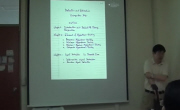본 연구는 Iacoviello and Neri(2010)의 동태확률 일반균형(DSGE) 모형에 국내 학군과 주택가격의 관련성이 높다는 점에 착안하여 교육비지출 시계열을 추가하여 주택가격지수의 변동을 분석한 것이...
http://chineseinput.net/에서 pinyin(병음)방식으로 중국어를 변환할 수 있습니다.
변환된 중국어를 복사하여 사용하시면 됩니다.
- 中文 을 입력하시려면 zhongwen을 입력하시고 space를누르시면됩니다.
- 北京 을 입력하시려면 beijing을 입력하시고 space를 누르시면 됩니다.
https://www.riss.kr/link?id=A107765727
- 저자
- 발행기관
- 학술지명
- 권호사항
-
발행연도
2021
-
작성언어
Korean
- 주제어
-
등재정보
KCI등재
-
자료형태
학술저널
-
수록면
58-90(33쪽)
- 제공처
- 소장기관
-
0
상세조회 -
0
다운로드
부가정보
국문 초록 (Abstract)
본 연구는 Iacoviello and Neri(2010)의 동태확률 일반균형(DSGE) 모형에 국내 학군과 주택가격의 관련성이 높다는 점에 착안하여 교육비지출 시계열을 추가하여 주택가격지수의 변동을 분석한 것이다. 그리고 모형의 계수의 분포를 추정한 후 주택선호 충격을 비롯한 다양한 충격과 주택담보대출 규제(LTV)가 변화할 경우 주택가격지수의 변동에 미치는 효과를 검토하였다.
주요 결과는 첫째, 여러 충격 중 주택가격지수변동의 가장 큰 원인은 주택선호충격으로 나타났다. 반면, 교육비 지출 관련 충격이 주택가격의 변동에 미치는 영향이 크지는 않았지만 일반소비의 축소에 영향을 미친 것으로 나타났다. 또한, 주요 금융 규제정책인 LTV(비율)의 축소(강화)는 주택가격지수의 안정화에 미치는 영향은 제한적이었다. 한편, 주택담보대출의 LTV 규제 강화가 소비 규모의 축소에 직접적인 영향을 미치는 것으로 나타났다.
다국어 초록 (Multilingual Abstract)
This paper looked into the relationship between Korea’s housing price fluctuations from 1996Q1 to 2016Q4 and 11 variables(Educational expenditure, Real consumption, Real business investment, Working hours in housing sector, Working hours in consumpt...
This paper looked into the relationship between Korea’s housing price fluctuations from 1996Q1 to 2016Q4 and 11 variables(Educational expenditure, Real consumption, Real business investment, Working hours in housing sector, Working hours in consumption sector, Real housing prices, Real residential investment, Inflation, Nominal interest rate, Wage inflation in consumption sector, Wage inflation in housing sector). Mainly using and modifying Iacoviello and Neri(2010)’s DEGE model and after Lim Hyoung Seok(2009) and Kang Hee Don(2006), Song In Ho(2014), this paper tries to add a new variable(educational expenditures) to the model in analyzing the causes of the housing prices changes in Korea.
Findings of this paper are First, Iacoviello and Neri(2010) model fairly effectively well explained Korea’s housing price volatility from 1996.01Q~2016.4Q in terms of Impulse Response Function to the given shocks. The most influential to housing price volatility was housing technology shocks. Monetary policy shocks turned second influential, educational cost shocks played little parts.
Second, the main cause of constant rise of housing prices are the wage rigidity in the housing construction area. And the limited land supply was responsible for the price volatility.
Third, when LTV ratio(m) was toughened from 80% to 60%, IRFs showed that, during early lags, the housing prices showed less responses to housing preference shocks. These experiments suggest that when financial regulations such as LTV(m) are tightened, it could reduce comsumption rather than stabilizing housing prices.
목차 (Table of Contents)
- 국문초록
- Ⅰ. 서론
- Ⅱ. 모형
- Ⅲ. 모수의 추정
- Ⅳ. 결론
- 국문초록
- Ⅰ. 서론
- Ⅱ. 모형
- Ⅲ. 모수의 추정
- Ⅳ. 결론
- 참고문헌
- Abstract
동일학술지(권/호) 다른 논문
-
한국과 중국 국민의 정치문화 비교: 정치적 태도의 분석
- 동국대학교 사회과학연구원
- 이재철(Lee, Jaechul)
- 2021
- KCI등재
-
기업지배구조가 조세혜택과 기업성과 간의 관계에 미치는 영향
- 동국대학교 사회과학연구원
- 이희라(Lee, Hee Ra)
- 2021
- KCI등재
-
코로나19 팬데믹과 복지국가: 북유럽 복지국가는 왜 지원에 인색했을까?
- 동국대학교 사회과학연구원
- 윤홍식(Yoon, Hong Sik)
- 2021
- KCI등재
-
한국의 급격한 자본 흐름에 영향을 미치는 요인 및 시사점
- 동국대학교 사회과학연구원
- 김유미(Kim, Yu Mi)
- 2021
- KCI등재





 DBpia
DBpia




